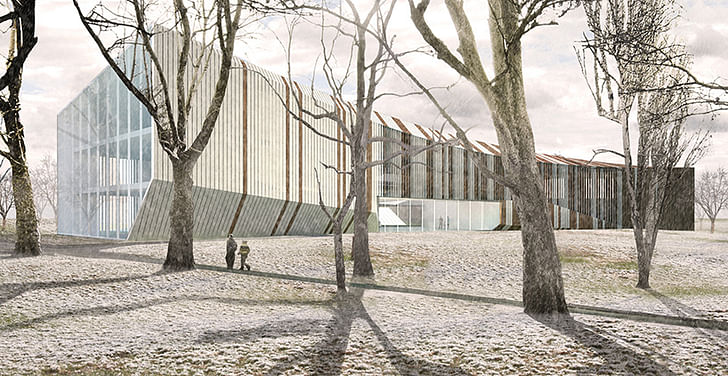

Putting together a portfolio for a job application is practically a design commission in of itself. What projects should be included? How should they be presented? Most importantly, what does the compendium of work say about you, the applicant? After speaking with employers, we discovered that the work itself isn’t necessarily as important as the thought and agility the portfolio demonstrates.
Whether you’ve been designing highly experimental academic forms or a series of developer-backed condos, the way you present your work is crucial. In future installments of this series, we will explore the importance of not biting off more than you can chew when articulating your role on a particular project in an interview. The same goes for the selection of work that you put together; make sure that it concisely represents your design sensibility, not simply a flashy version of what you think your design sensibility should be. While graphical execution is crucial, if you don’t understand and showcase your underlying approach and philosophy, no one else will, either. We specifically asked employers: How much work should an applicant include in their portfolio? Should that work be tailored to the specific types of projects the firm undertakes, or is it important to see a broad range of what the applicant can do?Q: Should work in a portfolio be tailored to the specific types of projects the firm undertakes, or is it important to see a broad range of what the applicant can do?

Katz Architecture
Firm Size: 1-25 People
Based: New York, New York
Typical Type of Work: Residential and Commercial Retrofits, Relocation and Design
Commentator: David Katz, Principal/Owner
It depends on what we’re hiring for. We may get a job type that is not typical of what we do. Therefore, it’s interesting to see if someone has done that type of work before. The types of skills that we would look for—good coordinating and management skills—are related to the complexity of the work they’ve done and the amount of time they’ve spent on a project as much as the process and however that’s conveyed. That’s true whether they choose to convey that verbally or through the materials they submit. For younger staff, it’s common to see a lot of academic work, which is always interesting.

Development One
Firm Size: 1-25
Based: Orange County, California
Typical Type of Work: Architecture and Project Management Firm, Aerospace/Specialized Industry
Commentator: J. Bruce Camino, Principal/Owner
We will definitely look at the portfolio. We’ve already looked at their credentials, what college they attended, and what their interests are. If someone is close to getting licensed, then the candidate must know something. There’s going to be standards at every firm that are different. If there’s something that’s going to stand out, it’s their level of detail. There are a lot of great designers out there. Ultimately, what’s going to separate a candidate from a great designer is the level of detail. The work itself is important, but it’s not as important as the presentation.

Marpillero Pollak Architects
Firm Size: 1-25
Based: New York, New York
Typical Type of Work: Urban, Institutional and Residential Architecture
Commentator: Sandro Marpillero, Founding Partner
In terms of putting together a portfolio with work tailored to match our projects, we’re not necessarily looking for interiors versus, whatever. We’re small and, so to speak, agile. We do very different work. We are not hospitality specialists, for example. It wouldn’t be easy to match our type of work. However, there needs to be some evidence of design work of quality within the portfolio. Also, the way we look at the work depends on the applicant’s experience. They might have had their own practice as opposed to only working for firms. One needs to be aware that they’ve had greater opportunities. It’s always possible to see great design if it comes through what they’ve actually done.

Fielding Nair International
Firm Size: 250+
Based: Internationally, with seven offices in Australia, India, and the United States
Typical Type of Work: Educational Facilities Planning and Architecture Design
Commentator: Randall Fielding, Chairman Minneapolis Studio
We’re looking for evidence of creativity and skill. If someone has done terrific-looking work in office buildings and residences that we don’t necessarily require in school design, we’re more likely to hire them because they’re demonstrating excellent fundamentals. We find that if the applicant is an expert in school design they usually have to be deprogrammed to match our sensibility and process.

Lorcan O’Herlihy
Firm Size: 1-25
Based: Culver City, California
Typical Type of Work: Institutional Buildings, Public Works, Large-Scale Developments, Residential
Commentator: Alex Anamos, Managing Director
Don’t target work that mimics ours—we look for evidence of thoughtfulness about architecture, whether that’s demonstrated through research, entries into projects, or work at other firms. We’re interested in people who are always asking themselves questions about what architecture is to them, because we’re always asking what architecture is to us. Also, we’re constantly exploring how we are trying to impact cities. We like to see evidence of the individual having these kinds of design values. Architecture is a constant conversation for us.Architecture is a constant conversation for us. We don’t start our Monday morning staff meetings with a run down of project status: we start with “Juice Bar.” Sometimes this takes the form of a conversation about design, other times the arts. This is why we’re here: we’re always mindful of our contribution to the larger design dialogue. We want people who are very aware of all of those issues.
Are you an employer who would like to talk about what you like to see from an applicant? Please send a note to: julia@archinect.com
For up-to-the-minute job listings, please visit Archinect's job board, and keep an eye out for future installments of the "EMPLOY(ED)" series. We'll be exploring all aspects of employment, from managerial concerns to portfolio tips to the day-to-day studio culture of some of the world's largest firms.
Julia Ingalls is primarily an essayist. Her work has appeared or is forthcoming in Slate, Salon, Dwell, Guernica, The LA Weekly, The Nervous Breakdown, Forth, Trop, and 89.9 KCRW. She's into it.
No Comments
Block this user
Are you sure you want to block this user and hide all related comments throughout the site?
Archinect
This is your first comment on Archinect. Your comment will be visible once approved.